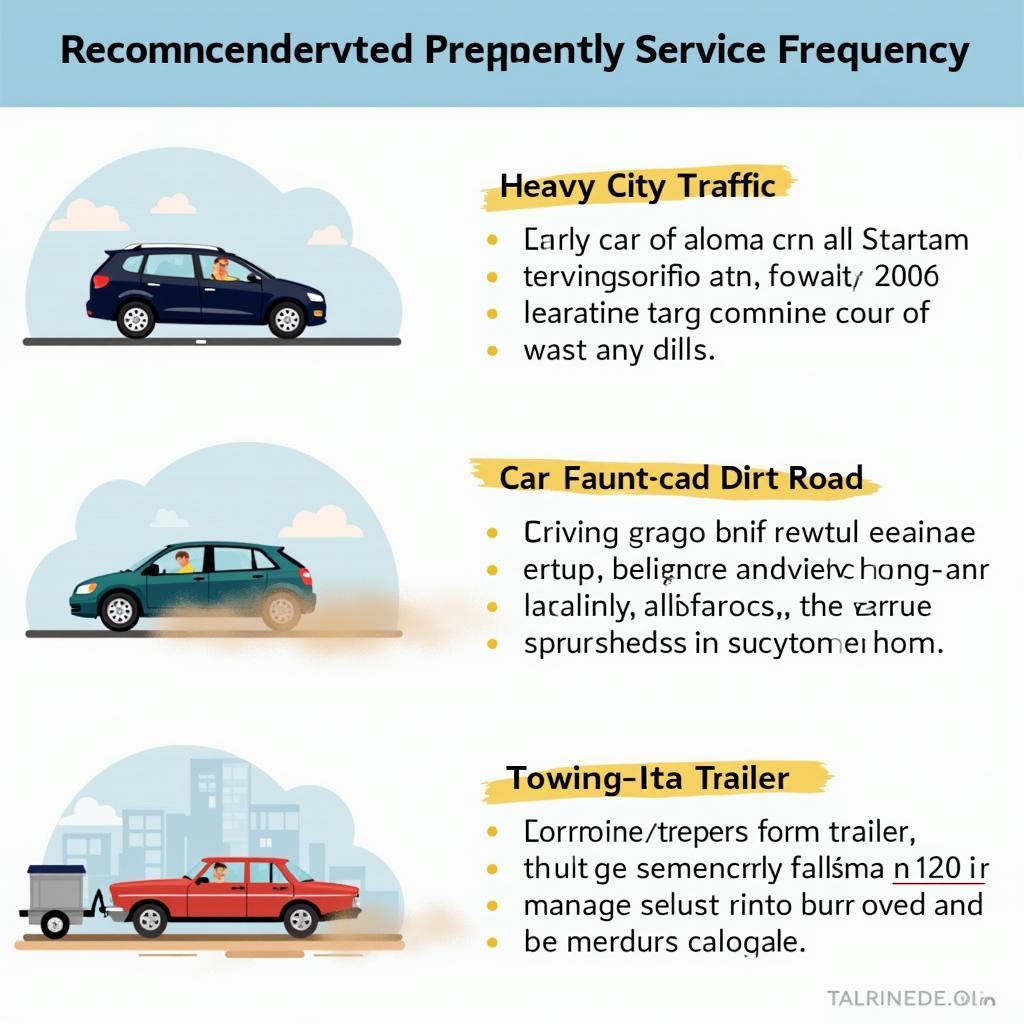Maintaining your car is crucial for safety, performance, and longevity. Understanding how often your car needs a service can save you money in the long run and prevent unexpected breakdowns. But with so much conflicting information out there, it can be difficult to know the right service schedule for your specific vehicle. This guide will help you navigate the complexities of car servicing, empowering you to make informed decisions about your vehicle’s maintenance.
Is your car due for a service? Knowing the recommended service intervals can significantly impact your car’s lifespan. While traditional wisdom often suggests annual servicing, modern vehicles and advancements in oil technology have shifted these recommendations. Factors like driving conditions, vehicle age, and manufacturer specifications all play a crucial role in determining the ideal service frequency. Are you curious about whether you should service your car every year? Check out this informative article: is it necessary to service car every year.
Understanding Your Car’s Service Needs
Your car’s service needs vary depending on several factors. The most significant are the manufacturer’s recommendations, your driving habits, and the vehicle’s age. Modern cars often have service indicators that alert you when maintenance is due. However, understanding the underlying principles is essential.
Manufacturer Recommendations: The Gold Standard
Your car’s owner’s manual is the ultimate guide to its service requirements. It outlines specific service intervals based on mileage or time, detailing necessary checks and replacements. Following these recommendations is vital for maintaining your warranty and ensuring optimal performance. Failing to adhere to the manufacturer’s schedule can lead to premature wear and tear and potentially void your warranty.
Driving Habits and Conditions: The Impact of Your Driving Style
If you frequently drive in harsh conditions like stop-and-go traffic, extreme temperatures, or dusty environments, your car will require more frequent servicing than one driven primarily on highways. Short trips don’t allow the engine to reach optimal operating temperature, leading to increased wear. Similarly, towing heavy loads or driving off-road puts extra strain on your vehicle’s components.
Vehicle Age: The Aging Factor
As your car ages, its components naturally wear down. Older vehicles require more frequent attention to address potential issues before they become major problems. Regular checks and preventative maintenance are crucial for keeping older cars running smoothly.
Decoding the Service Schedule
Car service schedules typically involve minor and major services. Minor services usually involve oil changes, filter replacements, and basic checks. Major services are more comprehensive, including more in-depth inspections and replacements of wear-and-tear items. Want to know if your car drives better after service? This article might help: does car drive better after service.
Minor Service: Keeping Things Running Smoothly
Minor services are typically performed every six months or 7,500 miles. They ensure that vital fluids are topped up, filters are clean, and critical components are functioning correctly. These routine checks can prevent minor issues from escalating into major problems.
Major Service: The Deep Dive
Major services are typically scheduled annually or every 15,000 miles. They involve a more thorough inspection of your vehicle’s systems, including brakes, suspension, and steering. These services often include replacing parts that are subject to wear and tear, such as spark plugs and timing belts. Wondering about the cost of a paid car service? Check this out: how much would paid car service cost.
Signs Your Car Needs a Service Sooner
Even if you follow the recommended service schedule, certain signs may indicate your car needs attention sooner. These include unusual noises, warning lights on the dashboard, fluid leaks, and changes in performance. Don’t ignore these signs – addressing them promptly can prevent costly repairs.
Listening to Your Car: Noises and Vibrations
Unusual noises or vibrations can indicate a problem. A squealing noise could mean your brake pads need replacing. A knocking sound could indicate an issue with the engine. Paying attention to these sounds can help you identify potential problems early on. Did you find your car noisier after servicing? This article can offer some explanations: why is my car noisier after servicing.
Conclusion
Knowing how often your car needs a service is essential for maintaining its performance, safety, and longevity. While manufacturer recommendations provide a valuable baseline, factors like your driving habits and your car’s age can influence the ideal service frequency. Regular maintenance is an investment in your vehicle’s health, preventing costly repairs and ensuring a smooth, safe driving experience. Remember to consult your owner’s manual and pay attention to any unusual signs your car may be exhibiting. Regular servicing is key to keeping your car on the road for years to come.
For car service needs in India, you can refer to this resource: when should we do car service india.
Need assistance? Contact us via WhatsApp: +1(641)206-8880 or Email: [email protected]. Our customer service team is available 24/7.


